
Cod is the common name for the demersal fish genus Gadus, belonging to the family Gadidae. Cod is also used as part of the common name for a number of other fish species, and one species that belongs to genus Gadus is commonly not called cod.

Herring are forage fish, mostly belonging to the family of Clupeidae.
The Cetomimiformes or whalefishes are an order of small, deep-sea ray-finned fish. Some authorities include the whalefishes as part of the order Stephanoberyciformes, within the superfamily Cetomimoidea. Their sister order, the Beryciformes, includes the flashlight fish and squirrelfish.

Cetomimidae is a family of small, deep-sea cetomimiform fish. They are among the most deep-living fish known, with some species recorded at depths in excess of 3,500 m (11,500 ft). Adults are known as flabby whalefishes while juveniles are known as tapetails and were formerly thought to be in a separate family, dubbed Mirapinnidae. Adults exhibit extreme sexual dimorphism, and the adult males were once thought to be exemplars of still another family, Megalomycteridae.
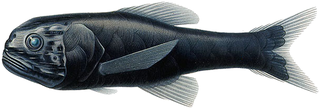
The Stephanoberyciformes are an order of marine ray-finned fishes, consisting of about 68 species, the majority (61) of which belong to the ridgehead family (Melamphaidae). The Stephanoberyciformes are mostly uncommon deep-sea species with little, if any, importance to commercial fishery. They share many morphological similarities with the Beryciformes, their sister order.

The Gonostomatidae are a family of mesopelagic marine fish, commonly named bristlemouths, lightfishes, or anglemouths. It is a relatively small family, containing only eight known genera and 32 species. However, bristlemouths make up for their lack of diversity with relative abundance, numbering in the hundreds of trillions to quadrillions. The genera Cyclothone is thought to be one of the most abundant vertebrate genera in the world.

Fangtooths are beryciform fish of the family Anoplogastridae that live in the deep sea. The name is from the Greek anoplo, meaning "unarmed", and γαστήρ, meaning "stomach". With a circumglobal distribution in tropical and cold-temperate waters, the family contains only two very similar species in one genus, with no known close relatives.
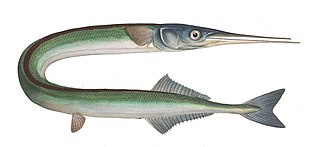
The garfish, also known as the garpike or sea needle, is a pelagic, oceanodromous needlefish found in brackish and marine waters of the Atlantic Ocean and the Mediterranean, Caribbean, Black, and Baltic Seas.
The velvet whalefish is a deep-sea whalefish, the sole known member of its family Barbourisiidae. It is found throughout the tropical and temperate parts of the world's oceans, mainly in the Pacific near Japan and New Zealand, at depths of 300–2,000 m. This species seems very closely related to some flabby whalefish and it was initially believed to belong to that family by some. They have been found from 65°N–40°S in the Atlantic, 50°N–50°S in the Pacific, and 5–20°S in the Indian Ocean.
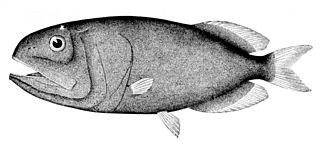
Rondeletia bicolor is a species of redmouth whalefish known only from the western Atlantic Ocean, where it is found at depths of around 3,003 m (9,852 ft). This species grows to a length of 11.2 cm (4.4 in).
Rondeletia loricata is a species of redmouth whalefish found in the temperate and tropical oceans at depths of from 100 to 3,500 m. This species grows to a length of 11.0 cm (4.3 in). It is known to be a vertical migrant, occurring at shallower depths at night.

Helicolenus percoides, the reef ocean perch, coral cod, coral perch, Jock Stewart, kuriarki, ocean perch, red gurnard perch, red gurnard scorpionfish, red ocean perch, red perch, red rock perch, scarpee or sea perch, is a species of marine ray-finned fish belonging to the subfamily Sebastinae, part of the family Scorpaenidae. It is found in the southwestern Pacific Ocean.
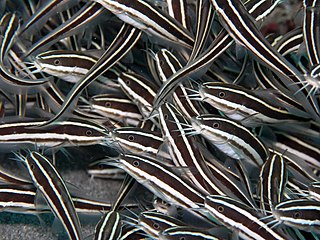
Plotosus is a genus of eeltail catfishes native to the Indian Ocean, the western Pacific Ocean and New Guinea.

Euleptorhamphus is a genus of halfbeaks in the order Beloniformes.
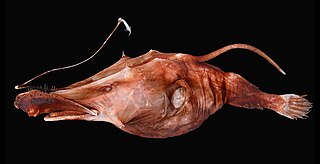
Lasiognathus is a genus of deep-sea anglerfish in the family Thaumatichthyidae, with six species known from the Atlantic and Pacific Oceans. It has been called a "compleat angler", in that its lure apparatus appears to consist of a fishing rod, a fishing line, bait, and hooks. It is also distinctive for an enormous upper jaw with premaxillaries that can be folded down to enclose the much shorter lower jaw.
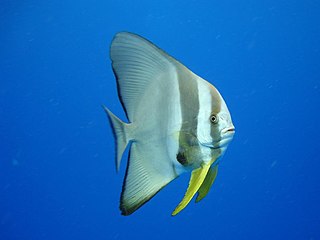
Platax is a genus of Indo-Pacific, reef-associated fish belonging to the family Ephippidae. There are currently five known extant species generally accepted to belong to the genus. They are one of the fish taxa commonly known as "batfish".

Black seadevils are small, deepsea lophiiform fishes of the family Melanocetidae. The five known species are all within the genus Melanocetus. They are found in tropical to temperate waters of the Atlantic, Indian, and Pacific Oceans, with one species known only from the Ross Sea.
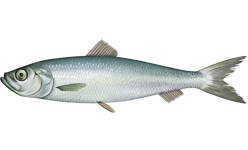
Clupea is genus of planktivorous bony fish belonging to the family Clupeidae, commonly known as herrings. They are found in the shallow, temperate waters of the North Pacific and the North Atlantic oceans, including the Baltic Sea. Two main species of Clupea are currently recognized: the Atlantic herring and the Pacific herring, which have each been divided into subspecies. Herrings are forage fish moving in vast schools, coming in spring to the shores of Europe and America, where they form important commercial fisheries.

Dermatias platynogaster is a species of dreamer found in the western Pacific Ocean where it occurs at depths of 549 to 1,342 m in the waters around the Philippines and in the area of the Magellan Seamounts. The females of this species grow to a length of 15.6 cm (6.1 in). This species is the only known member of its genus.

Citharichthys cornutus, the horned whiff, is a species of flatfish in the large-tooth flounder family Paralichthyidae. This bathydemersal marine fish inhabits the continental shelves of the western Atlantic Ocean, in both tropical and subtropical waters. It ranges from New Jersey in the north to Uruguay in the south, though larvae samples have also been collected off the coast of Canada. It occurs at depths between 30 and 400 metres, though it is usually found in deeper waters.

















